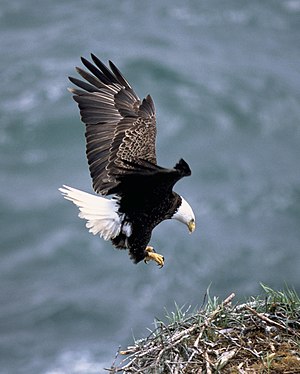White-tailed eagle (genus)
| White-tailed eagle | ||||||||||
|---|---|---|---|---|---|---|---|---|---|---|

Bald eagle ( Haliaeetus leucocephalus ) |
||||||||||
| Systematics | ||||||||||
|
||||||||||
| Scientific name | ||||||||||
| Haliaeetus | ||||||||||
| Savigny , 1809 |
The white-tailed eagles ( Haliaeetus ) are a genus of birds from the hawk family .
description
The genus Haliaeetus includes large to very large species without exception . The smallest species is the Madagascar sea eagle with a length of 60-66 cm and a wingspan of 1.60 to 1.80 m and a weight of 2.2 to 3.5 kg, the largest species is the giant sea eagle with a length of 85 –105 cm, a wingspan of up to 2.90 m and a weight of 4.9 to 9.0 kg.
Common features of the genus are the very broad (with the exception of the giant sea eagle) board-shaped wings, a relatively short, often wedge-shaped tail, the mostly very large and powerful beak, and the largely featherless tarsometatarsus . In almost all species (with the exception of the Solomon Sea Eagle ) the tail is largely or completely white. In all species, the young birds are markedly different in color from the adult eagles, and the full adult plumage is only acquired after several years.
The courtship and district "singing" of all kinds consists of sequential, more or less melodious calls. The head is thrown upwards (e.g. with sea and bald eagles) or even on the back (e.g. with fish eagles). As far as is known, the breeding pairs often sing in duets in all representatives of the genus.
distribution
The distribution of the genus is almost cosmopolitan (not in South America), but only one species occurs in America, the bald eagle .
species
The genus comprises eight species, another fossil species, H. piscator , is known from the middle Miocene of France ( Sansan ).
- White-tailed eagle ( H. albicilla )
- Bald eagle ( H. leucocephalus )
- White-bellied sea eagle ( H. leucogaster )
- Sea eagle ( H. leucoryphus )
- Giant Sea Eagle ( H. pelagicus )
- Solomon Sea Eagle ( H. sanfordi )
- Fish eagle ( H. vocifer )
- Madagascar sea eagle ( H. vociferoides )
ecology
Almost all species of the genus show a close connection to larger bodies of water, only the Solomon sea eagle also hunts in the interior of forests. The large wing area, which enables the use of even low updrafts, is interpreted as an adaptation to the low thermals over open water. The food mainly consists of fish and waterfowl, depending on the habitat, mammals and reptiles are only captured more frequently locally. As far as is known, carrion is regularly ingested by all species. Many species act as nest robbers, especially the smaller species often parasitize other bird species.
Reproduction
All representatives of the genus build large voluminous nests (clumps) on trees or on rocks, exceptionally on the ground. As far as is known, there is only one brood per year. The clutch size is 1–4 eggs. The nestlings are not very aggressive towards one another, cainism only occurs occasionally.
literature
- James Ferguson-Lees, David A. Christie: Raptors of the world . Helm, London 2001, ISBN 0-7136-8026-1 .
- Wolfgang Fischer: The sea eagles ( Neue Brehm library , vol. 221). A. Zimsen, Wittenberg 1984, DNB 840355157